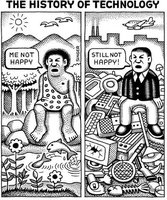You are using an out of date browser. It may not display this or other websites correctly.
You should upgrade or use an alternative browser.
You should upgrade or use an alternative browser.
Humans not smarter than animals
- Thread starter Anorion
- Start date
beingGamer
In the zone
Chetan1991
Youngling
I call BS. Sounds like the subjectivity crap theories flying around.
Watch this: David Christian: The history of our world in 18 minutes | Video on TED.com
Animals might be better at specific tasks than us. A specialization of an animal doesn't make it better than us humans.
Their rate of adaption and learning is governed by evolution, which, while way more error-free than our methods, is very slow.
OTOH we humans can adapt and survive by by using "collective learning." which can occur phenomenally faster than evolution.(Watch the video in link for description)
The most basic urge of any organism is survival, and in my opinion the species which can survive in the most variety of environments is most successful.
We can live in space now and might send humans to live on Mars in near future; that makes us the most successful species.
Watch this: David Christian: The history of our world in 18 minutes | Video on TED.com
Animals might be better at specific tasks than us. A specialization of an animal doesn't make it better than us humans.
Their rate of adaption and learning is governed by evolution, which, while way more error-free than our methods, is very slow.
OTOH we humans can adapt and survive by by using "collective learning." which can occur phenomenally faster than evolution.(Watch the video in link for description)
The most basic urge of any organism is survival, and in my opinion the species which can survive in the most variety of environments is most successful.
We can live in space now and might send humans to live on Mars in near future; that makes us the most successful species.
Update on this
A New Scientific Model that Defines Alien Intelligence
that also answers this question
A New Scientific Model that Defines Alien Intelligence
that also answers this question
Quick question: What is intelligence?
Historically, our measures of nonhuman intelligence has looked like this:
Physical measurements: brain to body ratio, brain structure/convolution/neural density, presence of artifacts and physical tools
Observational and sensory measurements: sensory signals, complexity of signals, cross-modal abilities, social complexity
Data mining: information theory, signal/noise, pattern recognition
Experimentation: memory, cognition, language comprehension/use, theory of mind
Direct interfaces: one way and two way interfaces with primates, dolphins, birds
Accidental interactions: human/animal symbiosis, cross-species enculturation
But these are mostly "human-like" attributes and measures. Most scientists are often reluctant to consider other types of intelligence that may not have human analogues.
"[Our] abilities to profile 'types' of intelligence that differ on a variety of scales is weak," writes Herzing. "Just as biologists stretch their definitions of life to look at extremophiles in unusual conditions, so must we stretch our descriptions of types of minds and begin profiling, rather than equating, other life forms we may encounter."
Intelligence is COMPLEX
To that end, Herzing has proposed a new approach to profiling a variety of nonhuman intelligences along multiple dimensions. Called COMPLEX (COmplexity of Markers for Profiling Life in EXobiology), it looks like this:
EQ: Encephalization Quotient
CS: Communication Signal complexity
IC: Individual Complexity
SC: Social Complexity
II: Interspecies Interaction
For example, dolphins have a high encephalization quotient, they engage in complex communication, and have big brains. The octopus is capable of associative learning, tameness, and exploratory behavior. Bees have collective intelligence, a symbolic waggle dance, and are capable of counting and learning. Even bacteria can exhibit complex behavioral responses without having to evolve complex brains. As for machine intelligence, namely AI, it demonstrates intelligence via neural networks, computational power, and algorithms.
To scale these markers, Herzing used a small set of taxa devised by biologists Lori Marino and Kathryn Denning. Each category was scored by experts on a scale from 1 to 10. Using this system, dolphins scored high in most categories, bees and machines scored relatively high in both the Communication Signal and Social Complexity categories, and microbes scored high in terms of Interspecies Interaction.
Harsh Pranami
Padawan
Bullshit! Humans have the capability to adapt like no one else. Of course through science. Animals can't do that
Humans are ahead in only in terms of Science & Living other than that Animals are superior
Yet, Humans developed science, which forms a solid repository of knowledge that he can use to better understand the world and our place in the universe and helped him make further progress and developments in technology that makes our lives comfortable. Animals on the other hand are driven by instinct, they have simply not evolved to the same level as humans because their ancestors did not feel the need for higher intellect and/or did not mutate in a way that they would develop such a level of sentience. Of course, humans cannot do everything that an animal can but that is because the human body has limitations and is not built for the speed of a cheetah or the strength of a elephant. However, humans evolved intellect as a way to compensate for the serious limitations of the body. This intellect helped the first humans develop more efficient methods to hunt and methods to farm which has more or less propelled us to where we are now. Animals on the other hand, are built in a way that best serves the environment they live in and their level of sentience is as much as is needed to survive. That is all to it.
Even if you cite complex communication methods employed by so many animals, they are still pretty simplistic as compared to the lakhs of words worth of vocabulary that an average human has.

